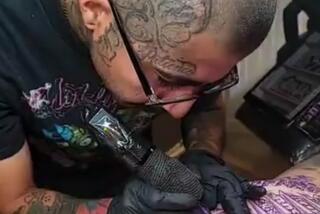Topics : FINE ARTS : Print Technique Poses Question: Is It Real or Is It a Serigraph? : A Torrance studio uses a painstaking procedure to reproduce designs in smaller sizes. Few studios in the L.A. area are equipped to do such work, which can take up to three months.
- Share via
Painter Leslie Sayour likes to splash color across big canvases when she paints.
But Japanese consumers, who pay as much as $55,000 for her impressionistic oil paintings, want art that fits into their small homes.
So Sayour, who sells most of her work in Japan, takes her paintings to Kolibri Art Studio in Torrance, where Herta Hedrick uses a painstaking printing technique called serigraphy to reproduce the designs in smaller sizes.
The prints, valued between $2,500 and $3,500, look so much like an original painting that it can be hard to tell the two apart. Typically artists request 200 to 500 copies of each work.
Since the studio opened at 2908 Oregon Court 3 1/2 years ago, it has reproduced about 55 works. Only about five studios in the Los Angeles area do fine-art serigraph printing.
Serigraphers separate and print each color in a painting. For brightly colored works such as Sayour’s, each print passes through the press more than 100 times.
The layers of ink coat the canvas and combine colors to duplicate the effects created by an oil painter. Special overlays of web-like black lines imitate the artist’s brush strokes. Five artists work full time for Hedrick to separate the colors.
It takes up to three months to complete a reproduction. Because of the hour it takes to set up the machine and the time it takes to dry, only about three colors can be put on each day.
Hedrick said the hardest part of her business is finding workers patient enough to endure the handiwork who also have an artistic sense. It takes technical skills and a good eye to do the work well.
“Just to be an artist is almost too imaginative and creative,” Hedrick said. “It’s just so much discipline.”
For each color, Hedrick’s artists black out portions of a transparent sheet, which is then used to make the plate that goes on the press. They rely on their own color sense to differentiate between similar tones on the canvas. The workers also mix the ink to exactly match the original.
Running the press takes equal skill. Each print must be placed in the printer exactly right or the colors won’t end up in the right place. The process is so exacting that even a Santa Ana wind causing a drop in humidity can shrink the paper enough to ruin the run.
Finding ways to duplicate each artist’s style keeps the work interesting, Hedrick said.
“If I had my choice I would love to work with one artist and really perfect his work,” she said.
Sayour said that sometimes the copies of her work outshine her originals. “If I ever notice differences, it’s always for the better.”
More to Read
The biggest entertainment stories
Get our big stories about Hollywood, film, television, music, arts, culture and more right in your inbox as soon as they publish.
You may occasionally receive promotional content from the Los Angeles Times.










